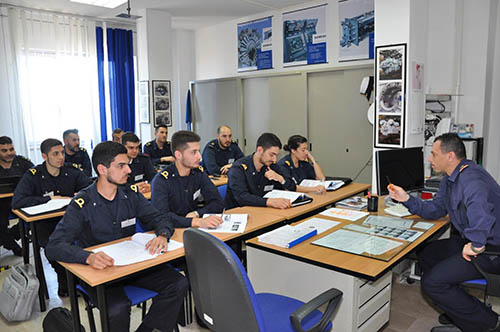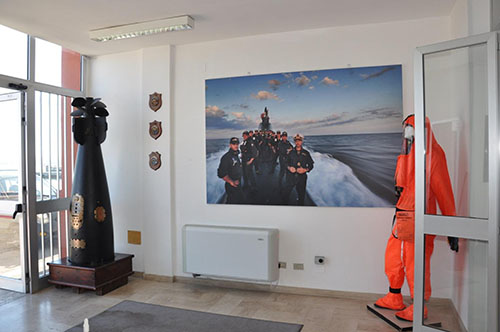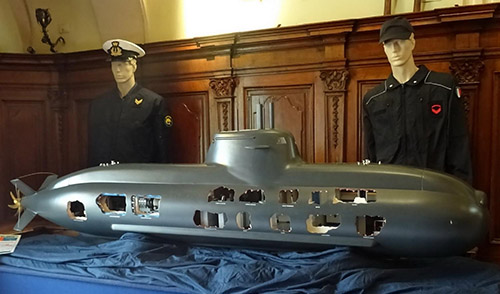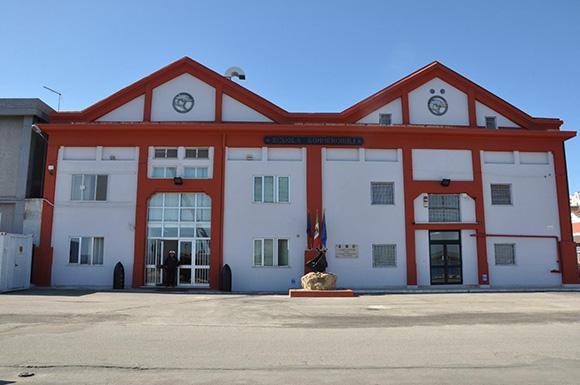"Men are not distinguished either by the titles or by what they have, but only for what they are". The submariners are "men of the sea" with a personal and human wealth of humility and courage. But they are also gifted men, of innate discipline, spirit of sacrifice, a high sense of responsibility, capacity for adaptation and mutual respect.
Every time I return to the Comflotsom I feel like I'm at home, whether I welcome the commander, the head of the public information office or the submariner who accompanies me at the structure, the reception is not reserved for the most welcome guest of the house. They really make me feel part of their "family" of submariners. The feeling of warmth of feeling at home is immediate.
Being submerged is not for everyone. And it's not for everyone. The submarines represent one of the components of "elites" of the Navy. Made up of highly motivated men and women.
The technical and operational peculiarities of submarines require crews who must be able to work in teams on board. Both men and women are masters of both the "platform" and the individual devices on which each of them will operate. The on-board systems and the required maneuvers are completely different from those of the naval units, they are exclusive of the submarines.
To be a submariner it is necessary to acquire a specific "forma mentis", first through a path of education and professional preparation, then through the experience on board the boat.
Those who choose to be a submariner today have a privilege: start their career process at a real "university of submarines" or the Submarine School, which trains and trains the men and women of the underwater component of the Navy.
La Submarine School, incorporated into the Training Service of the Submarine Flotation Command, is located in Mar Piccolo, in the beautiful city of Taranto, right in front of the docks where the boats moor.
 La Submarine School it is a real training center, able to train and specialize teams of motivated, prepared and continuously updated professionals. The aspiring submarers at the end of their training (theoretical and practical) at the School will operate on board as if they were one man.
La Submarine School it is a real training center, able to train and specialize teams of motivated, prepared and continuously updated professionals. The aspiring submarers at the end of their training (theoretical and practical) at the School will operate on board as if they were one man.
But how do you become professional of the abyss?
Since November 2015, only for boys (not yet for women) graduates, under the age of 25 years, the Italian Navy has allocated 30 places to those who want to embark on a unique and fascinating career as that of the submariner, as Volunteers in fixed farm (VFP1).
Becoming submerged as VFP1 is not the only way that even the soldiers in permanent permanent service can "apply" to become submergers. The basic training process is the same, but different in terms of duration and the same qualification for boarding submarines is acquired.
The boys who want to start this career as VFP1, participate in a call for competition organized by the Navy which provides a number of seats reserved just for the category submariners. If the candidate wins the competition, before entering the Component, he must follow a common classification, valid for all VFP1, of 1 about training week at MARISCUOLA Taranto. Later they will be sent to Brindisi, near the sea brigade Saint Mark where they perform another 5 period weeks where they are enabled to perform defense services to military installations. Subsequently 2 weeks at MARICENTADD Taranto for passive fire safety and antifalla defense courses. After this first training period, the VFP1s are sent to the sectors of employment required in the competition phase. The candidate who had applied to become a submariner will be sent to the Submarine School where the submersible enabling procedure begins.
A TBS or a basic submarine training composed of a theoretical part and a practical part.
They are waiting for 9 weeks at the Submarine School and other 11 weeks at the onboard Controls.
In the phase of completing the course of 9 weeks at the Submarine School they learn theoretical notions, at the end of this period they perform a first examination of specialized suitability. A necessary condition that allows it to continue the path undertaken.
Then in the next phase, that is on board, they learn practical notions. And during this period on board, the boat commander assesses the submarine ability of the student. It is essential that he has the real ability to work on board an underwater unit. At the end of these 20 weeks of training, they perform a final examination of this period, acquire the qualification and are therefore suitable for boarding the submarines.
After these 20 weeks of indoctrination will be sent to the various boats until the end of the year stops. Become sailors of the abyss, have also acquired a prestigious title of merit to continue, if they have the intentions, their career with the next competition for transit in VFP4. If they are winners of the VFP4 competition, they continue their process that, for the first few months, the number of which depends on the category, will be at Mariscuola Taranto, where he will be assigned the category specialist in the combat system, combat system technician, platform system specialist.
Depending on the category, there are different courses of different duration, with a maximum period of stay at the Officers' School not more than 6 months. Acquired the category as VFP4, then as a volunteer in a four-year firm will return to the Submarine School.
 At the School he will have to study in order to be able to take on the various positions on board and cover the various specialist roles. So it will have to know the on board equipment on which in submarines will go to operate if it belongs to the category "combat system specialist" (operational), or on which equipment board will have to do maintenance if it belongs to the category of "combat system technician "And" platform system specialist "(technicians). For how the local maneuver of a submarine is organized, on board, on the left side, looking at the bow, there are the technicians, on the straight side there are the operative ones. At the center is the officer in guard command. This provision of the on-board personnel is respected both on board the class boats Sauro, both on board the class boats Todaro. From the left side, the officer in command of the guard acquires information on the efficiency of the platform, from the straight side acquires information on the operating scenario that occurs on the surface or under water. So, for this reason it is also important that you return from the school where a new course will be prepared to learn and take the appropriate qualifications that will allow you to return on board the submarines with the "confidence" of the boat commander, depending on the equipment on board on which it will operate.
At the School he will have to study in order to be able to take on the various positions on board and cover the various specialist roles. So it will have to know the on board equipment on which in submarines will go to operate if it belongs to the category "combat system specialist" (operational), or on which equipment board will have to do maintenance if it belongs to the category of "combat system technician "And" platform system specialist "(technicians). For how the local maneuver of a submarine is organized, on board, on the left side, looking at the bow, there are the technicians, on the straight side there are the operative ones. At the center is the officer in guard command. This provision of the on-board personnel is respected both on board the class boats Sauro, both on board the class boats Todaro. From the left side, the officer in command of the guard acquires information on the efficiency of the platform, from the straight side acquires information on the operating scenario that occurs on the surface or under water. So, for this reason it is also important that you return from the school where a new course will be prepared to learn and take the appropriate qualifications that will allow you to return on board the submarines with the "confidence" of the boat commander, depending on the equipment on board on which it will operate.
Back on board, the VFP4 four-year-old volunteer, with the qualification and specific skills acquired in relation to his category, will work on his equipment for the next 4 years until the end of the stopping period, on board the submarine assigned to him.
After the 4 years the "military volunteer" will decide whether to continue his career with a new competition to access the career of the graduates, to subsequently become a sergeant or a non-commissioned officer. In addition, the VFP4 can participate in the regular public marshal competition, if it is still in possession of the age requirement (26 years elevated to 28 for having provided and completed voluntary military service).
If contest winner, he will always return to the Officers' School. In the competition assessment phase it is obvious that the difference will be the study performance during the training courses, which each candidate has achieved in these overall 5 years between the VFP1 and the VFP4. The characteristics of the on-board Command, on the attitude of the individual, will also be evaluated. And then the sector of employment they have chosen will also be evaluated and for the submariners they will have a "bonus" score because the boys have chosen a peculiar category, a sort of "incentive" in a hypothetical ranking in which everyone competes to enter be part of the actual service. The submariner with respect to the "naval" will have this sort of "bonus" that added to his performance over the years and also to the characteristics of the single military, will allow him to transit in the course for the effective permanent service. You will study to become a "graduate" first and possibly a sergeant or a non-commissioned marshal. In any case, their employment will be carried out by a submarine but the path must be completed by further courses always made to the Officers' School of Taranto and again by a further return to the Submarine School because as the military increases in rank and seniority, it will also increase its level of "operativity" on the equipment on board. In practice there is an increase in skills because the on-board job will be more and more prestigious and each member of the crew must be provided with more detailed information. They will allow him to go on board with a higher degree of preparation
The submariner has a continuous update through cyclical passages at the Submarine Training Center, which characterize the entire career and that will allow him to perform all the tasks related to his employment on board, until reaching the highest possible level for each role.
Every 2 years the submariner conducts medical examinations at military hospitals where he is subjected to a check-up complete and detailed in the analysis of the general state of health, psycho-physical efficiency and above all that all physical parameters are respected. If they were not, but still found to be optimal and comply with the parameters of the "naval" (less restrictive), the military would be temporarily or permanently employed on board the surface units. Obviously if it were a temporary submersible non-suitability, the military would be reinstated, after further medical check-ups and after a period of "training re-establishment", in Submersible component for use on board or on the ground. In the career course of the submariner, the assignments follow one another not only at the onboard Command, but try to alternate the period on board with a period "on the ground" at the Comflotsom. In this way we acquire notions concerning the logistics, training, administrative and technical aspects that support the boats and not only.
 In addition to individual training, there is also a "team formation" that is done periodically for all crews on the line. Usually this type of training is carried out when a submarine finishes one of the planned maintenance work cycles. The crew of that submarine before returning to the sea is referred to by the Submarine School where it is the staff work in teams, using dynamic simulators-dive coaches, of which the school has, which allow you to quickly reach a good level of training again.
In addition to individual training, there is also a "team formation" that is done periodically for all crews on the line. Usually this type of training is carried out when a submarine finishes one of the planned maintenance work cycles. The crew of that submarine before returning to the sea is referred to by the Submarine School where it is the staff work in teams, using dynamic simulators-dive coaches, of which the school has, which allow you to quickly reach a good level of training again.
These dynamic simulators faithfully recreate the local maneuver of both class submarines Sauro 3 ^ and 4 ^ series, both of the class submarines Todaro (U212).
You bring the platform in the limit conditions of a navigation, simulating a fire on board or a leak in the hull with consequent loss of altitude, certainly two of the most dangerous and dangerous events for a submarine and its crew. The readiness of the individual and the harmony of the ones is also assessed team in giving and receiving orders in extreme conditions trying to face the emergency in the best possible way without ever losing the focus of the primary mission. It can be imagined that the simulation of fire as an exercise, it is possible to do it also on board a submarine but it is clear that simulating a "flaw" is more complex, compromising the real safety of the crew and the boat. The School is also equipped with a fundamental flap simulator for training and teaming team.
This is the training aimed at "fire safety and antifalla" that can guarantee a safety margin on board during normal navigation. Then there are the diving simulators, which affect the "operational" part. Here the team is trained in approaching techniques, hydrophonic listening, kinematic maneuvers to be taken in certain scenarios such as the search for boats with migrants, fishing boats or merchant ships carrying out illegal trafficking. In the simulator you can load scenarios very close to reality, and record the whole tutorial for 4 hours. In the classroom debriefing the results obtained will be discussed.
The training process for a young submariner may seem harsh, but it is realistic and this helps him to define the skills he wants to acquire. For this reason we try to adapt teaching and organization to changing times and scenarios that may arise. The submariner must be able to meet his responsibilities, based on the degree, specialization and position held on board.
This is a complex and articulated training, which is carried out by an instructor with a high professional profile as well as experience and which avails itself of cutting-edge teaching tools and aids present at the Submarine School of Taranto.
La Submarine School 1 December 2015, as well as all the COMFLOTSOM, has undergone an internal restructuring in terms of services and departments, while the courses provided remain the same. The name of the operational and technical figures has changed within the School because there is a need to faithfully reflect the "technical-operational hierarchical structure" on board the boat. For on-board personnel interfacing with ground personnel at the same school, the approach is faster than the fastest. Find the same technical-operational figures at higher levels. Decision desired by the current commander of the submarines, division admiral Dario Giacomin (v. interview) and "embraced" by the whole Component. Now, for example, the old training and training department is called Training Service and the examples would follow in cascade.
La Submarine School is directly reporting to the captain of ship Stefano Russo, current commander of the submersible flotilla. While the school's chief training officer is the frigate captain Fabio Danese. The Comflotsom or the submersible flotilla command it is employed by MARICOSOM which is the submarine command of the Italian Navy.
MARICOSOM inherited the tasks that were of Comforsub, ie command of the underwater forces.
For young people who want to get to know the "world" of submarines and submarines of the Italian Navy, it must be said that they will start a qualified professional path. It will also be a psychological and personal journey that will mature their personality and accentuate their specific characteristics as well as attitudinal. This path will allow him through periodic returns to the Submarine School to raise their profile of specialization and experience. He will be able to align his skills to the tasks of increasing responsibility, which over time will take on board.
Read also: The Sommergibilisti School for the "sailors of the Abyss" (part one)












